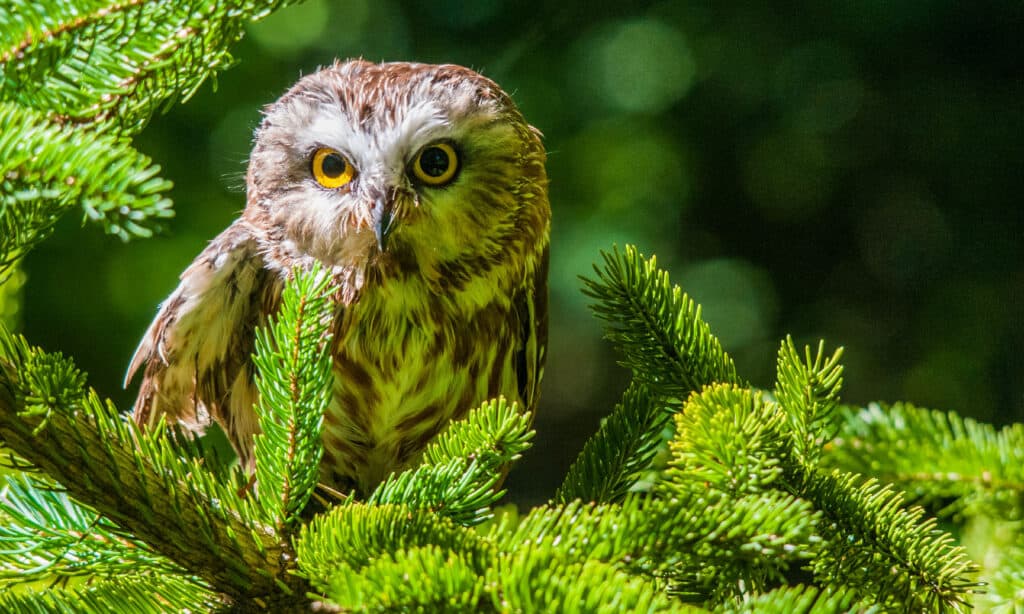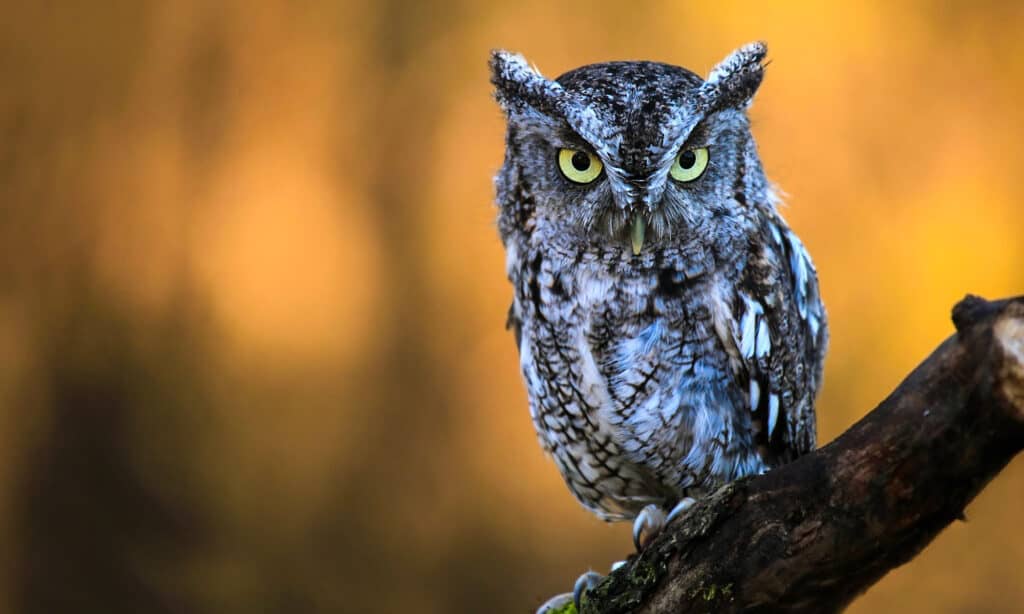Owls are notorious for being nocturnal, so the term “night owl” was coined to refer to someone who stays up late. However, this term is not 100% true, as some owls are active day hunters. So are owls nocturnal, diurnal, or do they have another sleeping and waking pattern altogether? Stay with us as we delve into the daily habits of these distinctive birds to learn whether owls are nocturnal or diurnal.
The Sleep Behavior of Owls Differ Across Species

Owls sleep for 10 to 12 hours each day and can be nocturnal, diurnal, crepuscular, or cathemeral.
©FotoRequest/Shutterstock.com
Owls sleep for 10 to 12 hours each day. Most owls are nocturnal as they hunt at night and sleep during the day. But some owl species are more flexible and will hunt in the morning or late afternoon, making them crepuscular. A few species of owl are even diurnal and sleep at night. Owl species that are predominantly nocturnal are the following:
- Barn owl
- Flammulated owl
- Eastern screech-owl
- Western screech-owl
- Whiskered screech-owl
- Great horned owl
- Spotted owl
- Elf owl
- Boreal owl
- Northern saw-whet owl
- Long-eared owl
Owl species that are predominantly diurnal are the following:
- Snowy owl
- Northern hawk owl
- Burrowing owl
Some owls even display nocturnal and diurnal behavior, hunting during the night or day. These owls are known to have cathemeral sleeping patterns. Examples of these owls are the following:
- Barred owl
- Great grey owl
- Northern pygmy owl
- Short-eared owl
So, owls are nocturnal, diurnal, crepuscular, or cathemeral due to the prey available in their environment. Some owls are picky eaters and hunt nocturnal, diurnal, or crepuscular prey. Because of these preferences, these owls align their sleeping patterns with their food sources.
Owls Experience REM Sleep
Like most birds, owls experience REM sleep but lack rapid eye movements because their eyes cannot move within their skull. REM sleep starts after an hour of entering the sleep state, and the first period usually lasts 10 minutes. Each subsequent period lasts a little longer. Brain activity increases, but the body enters a state of temporary paralyzation.
Where Do Owls Sleep?

Owls sleep in trees, rocky areas, on the ground, and sometimes underground, depending if they are nocturnal or otherwise.
©iStock.com/bookguy
Depending on the species, owls may sleep in trees, rocky areas, on the ground, or even underground. The United States is home to 18 owl species, each with unique sleeping behaviors. The location of the owl’s slumber depends on their species and habitat.
Owls prefer sleeping in a quiet, calm space away from predators and danger. Smaller species of owl, like screech-owls, sleep in cavities and birdhouses. Larger species of owl, like barred owls and great horned owls, sleep in the canopy of trees. One species of owl, the burrowing owl, sleeps in burrows underground. They either dig these burrows themselves or use abandoned burrows built by other animals.
Owls sleep in an upright perched position and grip onto the perch using their sharp talons and strong feet. Young owls are different and sleep lying down. They do this to rest their developing muscles. Most choose to do this in a nest, but some will sleep on a branch if they can get a firm grip. Owls have sensitive eyes and prefer napping with their eyes closed throughout the day. Although they sleep with their eyes closed, owls are always alert and will flee from the area if danger is near.
Sometimes Nocturnal Owls Sleep in Groups
Most owls are solitary animals but may sleep in groups in specific circumstances. Siblings that have recently left the nest will sometimes stay and sleep together. Adult nocturnal owls also choose to sleep together during the breeding season but prefer being solitary outside this period. Burrowing owls, the only underground species, live in colonies and are not solitary animals. Short-eared, long-eared, and great-horned owls sleep in groups only in winter. They conserve energy and heat while nesting in groups ranging up to 200 members.
Nocturnal or Not, Owls Have Excellent Night Vision
Many believe that owls have the most impressive night vision out of all animals, which may be true. Owls have large pupils and corneas that are very effective at collecting light. Cats are the only animal that can match an owl’s night vision abilities. They also have binocular vision with a duplex retina. Their retina has a high volume of rods, which is common in nocturnal animals. So even if the owl is nocturnal or something else, its eyes work well even in bright sunlight. Besides, not all species can see color, but some can differentiate between colors.
Owls have enormous eyes for the size of their heads. Some large species, such as the Great White Owl, have bigger eyes than most humans. Although owls have excellent vision, they also have their drawbacks. Unlike the eyes of most animals, owl eyes are flat rather than spherical. Because of this adaptation, owls cannot move their eyes. Instead, their eyes are anchored by a bony structure called a sclerosis ring.
Consequently, owls must rotate their head to move their eyes. However, owls can turn their heads far enough to see right behind them. Most owl species’ head rotation range is a whopping 270 degrees.
Nocturnal Owls Use Their Excellent Hearing To Locate Their Prey

Owls have eyes adapted for night vision and may have the best night vision out of all animals, even when they are not nocturnal.
©mlorenz/Shutterstock.com
Owls have well-developed ears, with some species’ auditory senses being ten times stronger than a human’s hearing. Owls need this ability to find prey that they can’t see with their exceptional eyesight. Their hearing is so powerful that they can hear small rodents scurrying under heavy snow.
Owls’ unique hearing system allows them to detect even the slightest sounds. However, their ears are not symmetrical like most animals. But even with their ears misaligned, owls can still identify the location of the finest sounds. When an owl hears potential prey, it moves its head in multiple directions to listen to the sound. Owls have oval face shapes. Combine this face shape with their exceptional auditory function, and owls possess a highly sensitive and precise hearing system.
Nocturnal vs. Diurnal: What’s The Difference?
Navigate to Nocturnal vs. Diurnal: What’s The Difference? for further information about the nocturnal and diurnal phenomenon in various living creatures.
Up Next – All About Owls
- Are Owls Raptors?
- Are Owls Mammals?
- The Largest Owl in the World
- Why Do Owls Hoot at Night?
- A Cat And An Owl Face Off in Backyard Brawl
The photo featured at the top of this post is © mlorenz/Shutterstock.com
Sources
- ResearchGate, Available here: https://www.researchgate.net/publication/229728618_Sensory_capacities_and_the_nocturnal_habit_of_owls_Strigiformes
- Springer Nature, Available here: https://link.springer.com/referenceworkentry/10.1007/978-3-319-47829-6_1171-1
- ResearchGate, Available here: https://www.researchgate.net/publication/270086555_A_Communal_Roosting_of_the_Great_Horned_Owl_Bubo_virginianus
- BioOne, Available here: https://bioone.org/journals/journal-of-raptor-research/volume-42/issue-2/JRR-07-20.1/Effects-of-Human-Land-Use-on-Western-Burrowing-Owl-Foraging/10.3356/JRR-07-20.1.full
- National Library of Medicine, Available here: https://www.ncbi.nlm.nih.gov/pmc/articles/PMC5979023/
- ScienceDirect, Available here: https://www.sciencedirect.com/science/article/pii/S0960982219315155
- National Academy of Science, Available here: https://www.pnas.org/doi/10.1073/pnas.2119217119#sec-4
- Springer Nature, Available here: https://www.nature.com/articles/srep33578
- Oxford University Press, Available here: https://academic.oup.com/gbe/article/12/10/1895/5889951#208574104
Thank you for reading! Have some feedback for us? Contact the AZ Animals editorial team.






